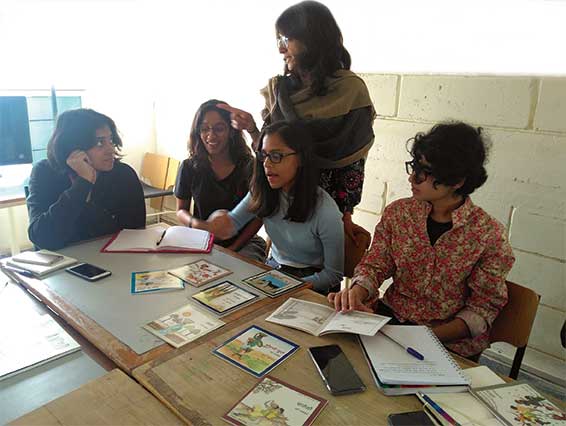Chatura Rao
I was last a student two and half decades ago. This was at the stately and serene Sophia College for Women in South Mumbai where I spent three years until I graduated in 1994 with a degree in English Literature. In recent days, I feel like I’ve returned in spirit. A busy but kind office superintendent, Ms. Boskey Martis, has been advising me on how to apply for a couple of lost marksheets. She coaches, sums up instructions, and addresses me as “dear” in the exasperated way that people address anxious students. I’m in my 40s, pursuing a Masters designed for mid-career professionals, attending night classes and completing assignments in the hours I have free from my day job, and she might well know this, but to her I’m a student trying to get things issued impossibly quick; she knows just how to hold off these fears over a phone call each day.

The year 1995 onwards, I left and never returned to the sloping tree-shaded lanes connecting Peddar and Warden Road that the Sophia campus sits astride. Instead I set off down a freeway, riding challenges of a writing career that has spanned reporting, journalism, children’s and adult fiction, and technical writing. I’ve been barely aware of the protective spaces that college once provided… but found my way to another such setting in 2019, first to teach and through teaching, to learn.
Taking the lanes of a quiet, tree-lined locality, this time in suburban Bengaluru, I’d walk through the open doors of the Srishti Institute of Art, Design and Technology, every morning. I was here to facilitate learning for undergraduates and for graduate students in the areas of information arts and creative writing. In between teaching cycles, I’d chaff at what I saw as the fetters of academic life, sorely missing professional and personal interactions in the “real world” that had fueled my writing practice. I didn’t miss these during the studios and workshops where my students and I would work together to understand the nuances of narratives and to search for and create our own.
In a studio called Rambling Ink, six creative writing students began with writing out pieces that another person, a close one, might have written about them. These were portraits in words that were to introduce themselves to the class and to me. S described herself from the point of view of a friend who was in love with her, yet helping her through a heartbreak. They were at a juice stall on a particularly difficult day and through his telling that is both affectionate and critical, we learn about her fragility, her strength, her stubbornness, and grief. We also understand his kindness, and S’s own insight into his concern for her. M wrote from the point of view of how their mother may have written about them, the morning the two spent in almost wordless anger, even as their mother drove M all the way to college. When M wrote about themselves from their mother’s point of view, they began to see the incident and their mother quite differently. These self-portraits were an honest and nuanced start to more intense fiction writing, sourced from their own lives. For me, besides the pleasure of helping them sift meaning and find a voice, the sight of them quietly typing away in the silver light of morning stirred a kind of joy I’d not known before. I fell in love with teaching.
Then last year, I returned to being a student, enrolling in a postgraduate arts programme at the Srishti-Manipal Institute itself, called Design in Education. Its studios and workshops have opened windows into areas of learning I hadn’t known of. Not in the building of skill and technique, but more with insights into diverse and possibly slower processes of knowledge-making than I’d been aware of. Everyone who has the time and support to engage with ideas and material discovers new ways to perform in the world. But I see now that to do this consciously and critically is to learn; and to share intentionally in knowledge-making is to teach and to learn.
Six months ago, I decided to complicate a teaching experience by shifting my position. I’d facilitate, but also participate in a short story writing class as a learner. I’d perform some of the writing exercises that the students were set, including write a short story. I’d offer my work to the students to review. This felt like a scary proposition, since writing a short story, while a passion, was still a nascent skill. My plot-making was weak. In the weeks leading up, I had faced a block with ideas. I felt vulnerable before my students who were discerning 20-year-olds.
First we appreciated and critiqued thought-provoking short stories. Then each student wrote two drafts of a story concept based off prompts that I put up. The class of nine worked its way to writing individual story outlines. They came up with feedback for each other’s outlines and for mine as well.

Two more students commented, appreciating some aspects and suggesting changes to others. I felt grateful for the feedback, understood better how learners take in suggestions for change, and most of all, resumed writing my story with a new enthusiasm.
Another, more subtle thing occurred: taking a listening stance surprised me out of a sense of complacency towards writing. It is the practise I profess to have skill at, and so ignore for being a territory conquered. But in reality, the word is both a source of light, my torch to explore the world, as well as my nemesis, the slippery thing I must wrestle with and often admit defeat to. My student-teachers, the three who took the time to read and respond to my draft, still walk with me in spirit on the old and new road to learning.
Next week I visit the office of the Sophia College for Women in Mumbai, a grey-haired ex-student, hoping that the two-and-half-decade-old marks cards may have been reprinted on gleaming white by Ms. Martis’ staff. They may not be. These things are done slowly and systematically under the high roofs of universities. Having tired of scrambling around, I may be handed them gracefully, in their own time, somewhat like knowledge and wisdom are.
This article was first published in the Srishti-Manipal Institute of Art, Design and Technology student magazine called Gatepass Captcha Episode 1 (2021).
The author is a children’s and adult fiction author, a journalist, and a teacher. Her writing centres around community practises, gender, and education. Her reportage has won Laadli Awards for gender sensitive reporting. Her recent picture book, The Sweet Shop Wars, is shortlisted for a 2023 Neev Book Award. She can be reached at chaturarao@gmail.com.
